A Fatigue Lifetime Prediction Model for Aluminum Bonding Wires
Abstract
:1. Introduction
2. Materials and Methods
2.1. Aluminum Bonding Wires
2.2. Tensile Testing
2.3. Fatigue Testing
2.4. Mathematical Description of Wöhler Lines
2.5. Quantitative Comparison of Experimental Data with Model Data
3. Results
3.1. Tensile Testing
3.2. Fatigue Testing for Lifetime Modeling
3.3. Fatigue Lifetime Prediction Model
3.3.1. Fit of the Experimental Fatigue Data
3.3.2. Linear Lifetime Model
3.3.3. Nonlinear Lifetime Model
3.4. Verification of the Extrapolation by Smith Diagrams
3.5. Transfer of the Fatigue Models to Further Aluminum Bonding Wires
4. Discussion
Author Contributions
Funding
Data Availability Statement
Acknowledgments
Conflicts of Interest
References
- Altenbach, H.; Dresbach, C.; Petzold, M. Characterizing the Anisotropic Hardening Behavior of Aluminum Bonding Wires. In Materials with Complex Behaviour II; Öchsner, A., Da Silva, L.F.M., Altenbach, H., Eds.; Springer-Verlag: Berlin/Heidelberg, Germany, 2012; pp. 583–598. [Google Scholar]
- Li, L.; Xu, S.; Liang, Y.k.; Wie, P. 10 mils Al wire heavy wedge bond wire deformation thickness study. In Proceedings of the 20th International Conference on Electronic Packaging Technology (ICEPT), Hong Kong, China, 12–15 August 2019. [Google Scholar]
- Levine, L. Wire Bonding. EDFAAO 2016, 18, 22–28. [Google Scholar] [CrossRef]
- Treto, R.; Kim, G. Optimization of Ultrasonic Aluminum Wire Bonding on Chromium and Gold Surfaces Using K&S Wedge Wire Bonder; Sing Center for Nanotechnology: Philadelphia, PA, USA, 2019. [Google Scholar]
- Merkle, L.; Kaden, T.; Sonner, M.; Gademann, A.; Turki, J.; Dresbach, C.; Petzold, M. Mechanical fatigue properties of heavy aluminium wire bonds for power applications. In Proceedings of the 2nd Electronics Systemintegration Technology Conference (ESTC), Greenwich, UK, 1–4 September 2008; pp. 1363–1368. [Google Scholar]
- Merkle, L.; Sonner, M.; Petzold, M. Lifetime prediction of thick aluminium wire bonds for mechanical cyclic loads. Microelectron. Reliab. 2014, 54, 417–424. [Google Scholar] [CrossRef]
- Merkle, L.; Sonner, M.; Petzold, M. Developing a model for the bond heel lifetime prediction of thick aluminium wire bonds. Solder. Surf. Mt. Technol. 2012, 24, 127–134. [Google Scholar] [CrossRef]
- Bai, C.; Fan, J.; Qian, C.; Guo, W.; Fan, X.; Zhang, G. Electrical-thermo-mechanical Simulation for Aluminum Wire Bonds in Sic Schottky Diode Packages. In Proceedings of the 2016 IEEE 13th China International Forum on Solid State Lighting: International Forum on Wide bandgap Semiconductors China (SSSLChina: IFWS), Beijing, China, 15–17 November 2016. [Google Scholar]
- Ciappa, M. Selected failure mechanism of modern power modules. Microelectron. Reliab. 2002, 42, 653–667. [Google Scholar] [CrossRef]
- Czerny, B.; Paul, I.; Khatibi, G.; Thoben, M. Experimental and analytical study of geometry effects on the fatigue life of Al bond wire interconnects. Microelectron. Reliab. 2013, 53, 1558–1562. [Google Scholar] [CrossRef]
- Wright, A.; Hutzler, A.; Schletz, A.; Pichler, P. Thermo-mechanical simulation of plastic deformation during temperature cycling of bond wires for power electronic modules. In Proceedings of the 2014 IEEE 15th International Conference on Thermal, Mechanical and Multi-Physics Simulation and Experiments in Microelectronics and Microsystems (EuroSimE), Ghent, Belgium, 7–9 April 2014. [Google Scholar]
- Jiang, N.; Scheibel, M.G.; Fabian, B.; Kalajica, M.; Miric, A.-Z.; Lutz, J. Effects of Inorganic Encapsulation on Power Cycling Lifetime of Aluminum Bond Wires. In Proceedings of the 30th International Symposium on Power Semiconductor Devices & ICs (ISPSD), Chicago, IL, USA, 13–17 May 2018; pp. 244–247. [Google Scholar]
- Packwood, M.; Li, D.; Mumby-Croft, P.; Dai, X. Thermal Simulation into the Effect of Varying Encapsulant Media on Wire Bond Stress Under Temperature Cycling. In Proceedings of the 2018 IEEE 19th International Conference on Electronic Packaging Technology (ICEPT), Shanghai, China, 8–11 August 2018; pp. 152–155. [Google Scholar]
- Czerny, B.; Khatibi, G. Accelerated mechanical fatigue interconnect testing method for electrical wire bonds. Tm-Tech. Mess. 2018, 85, 213–220. [Google Scholar] [CrossRef]
- Czerny, B.; Khatibi, G. Cyclic robustness of heavy wire bonds: Al, AlMg, Cu and CucorAl. Microelectron. Reliab. 2018, 88–90, 745–751. [Google Scholar] [CrossRef]
- Czerny, B.; Khatibi, G. Highly accelerated mechanical lifetime testing for wire bonds in power electronics. J. Microelectron. Electron. Packag. 2022, 19, 49–55. [Google Scholar] [CrossRef]
- Broll, M.S.; Geissler, U.; Höfer, J.; Schmitz, S.; Wittler, O.; Lang, K.D. Microstructural evolution of ultrasonic-bonded aluminum wires. Microelectron. Reliab. 2015, 55, 961–968. [Google Scholar] [CrossRef]
- Halouani, A.; Khatir, Z.; Shqair, M.; Ibrahim, A.; Pichon, P.-Y. An EBSD study of fatigue crack propagation in bonded aluminum wires cycled from 55 °C to 85 °C. J. Electron. Mater. 2022, 51, 7353–7365. [Google Scholar] [CrossRef]
- Loh, W.-S.; Corfield, M.; Lu, H.; Hogg, S.; Tilford, T.; Johnson, C.M. Wire Bond Reliability for Power Electronic Modules—Effect of Bonding Temperature. In Proceedings of the 2007 IEEE Thermal, Mechanical and Multipyhsics Simulation and Experiments in Micro-Electronics and Micro-Systems (EuroSimE), London, UK, 16–18 April 2007. [Google Scholar]
- Dornic, N.; Ibrahim, A.; Khatir, Z.; Degrenne, N.; Mollov, S.; Ingrosso, D. Analysis of the aging mechanism occurring at the bond-wire contact of IGBT power devices during power cycling. Microelectron. Reliab 2020, 114, 11373. [Google Scholar] [CrossRef]
- Khatibi, G.; Lederer, M.; Czerny, B.; Kotas, A.B.; Weiss, B. A New Approach for Evaluation of Fatigue Life of Al Wire Bonds in Power Electronics. In Light Metals 2014; Grandfield, J., Ed.; John Wiley & Sons, Inc.: Hoboken, NJ, USA, 2014; pp. 271–277. [Google Scholar]
- Ribbeck, H.-G.; Döhler, T.; Czerny, B.; Khatibi, G.; Geißler, U. Loop formation effects on the lifetime of wire bonds for power electronics. In Proceedings of the 11th International Conference on Integrated Power Electronic Systems (CIPS), Berlin, Germany, 24–26 March 2020. [Google Scholar]
- Yang, L.; Agyakwa, P.A.; Johnson, C.M. Physics-of-Failure Lifetime Prediction Models for Wire Bond Interconnects in Power Electronic Modules. IEEE Trans. Device Mater. Reliab. 2012, 13, 9–17. [Google Scholar] [CrossRef]
- Van der Wel, P.J.; Otte, R.; Roberts, H.; de Bruijn, F.; van Zuijlen, A.; Merkus, B. Electromigration behavior in aluminum wires for power base-station applications. In Proceedings of the 2017 IEEE International Reliability Physics Symposium (IRPS), Monterey, CA, USA, 2–6 April 2017. [Google Scholar]
- Lefranc, G.; Weiss, B.; Klos, C.; Dick, J.; Khatibi, G.; Berg, H. Aluminum bond-wire properties after 1 billion mechanical cycles. Microelectron. Reliab. 2003, 43, 1833–1838. [Google Scholar] [CrossRef]
- Naumann, F.; Schischka, J.; Koetter, S.; Milke, E.; Petzold, M. Reliability characterization of heavy wire bonding materials. In Proceedings of the 2012 4th Electronic System-Integration Technology Conference (ESTC), Amsterdam, The Netherlands, 17–20 September 2012; pp. 1–5. [Google Scholar]
- Moers, C.; Dresbach, C. Influence of R-Ratio on Fatigue of Aluminum Bonding Wires. Metals 2023, 13, 9. [Google Scholar] [CrossRef]
- Van Enkhuizen, M.J.; Dresbach, C.; Reh, S.; Kuntzagk, S. Efficient lifetime prediction of high pressure turbine blades in real life conditions. In Proceedings of the ASME Turbo Expo 2017: Turbomachinery Technical Conference and Exposition, Charlotte, NC, USA, 26–30 June 2017. [Google Scholar]
- DIN 50100:2022-12; Schwingfestigkeitsversuch—Durchführung und Auswertung von Zyklischen Versuchen mit Konstanter Lastamplitude für Metallische Werkstoffproben und Bauteile. Beuth Verlag: Berlin, Germany, 2022.
- Haibach, E. Betriebsfestigkeit Verfahren und Daten zur Bauteilberechnung, 3. Korrigierte und Ergänze Auflage; Springer-Verlag: Berlin/Heidelberg, Germany, 2006. [Google Scholar]

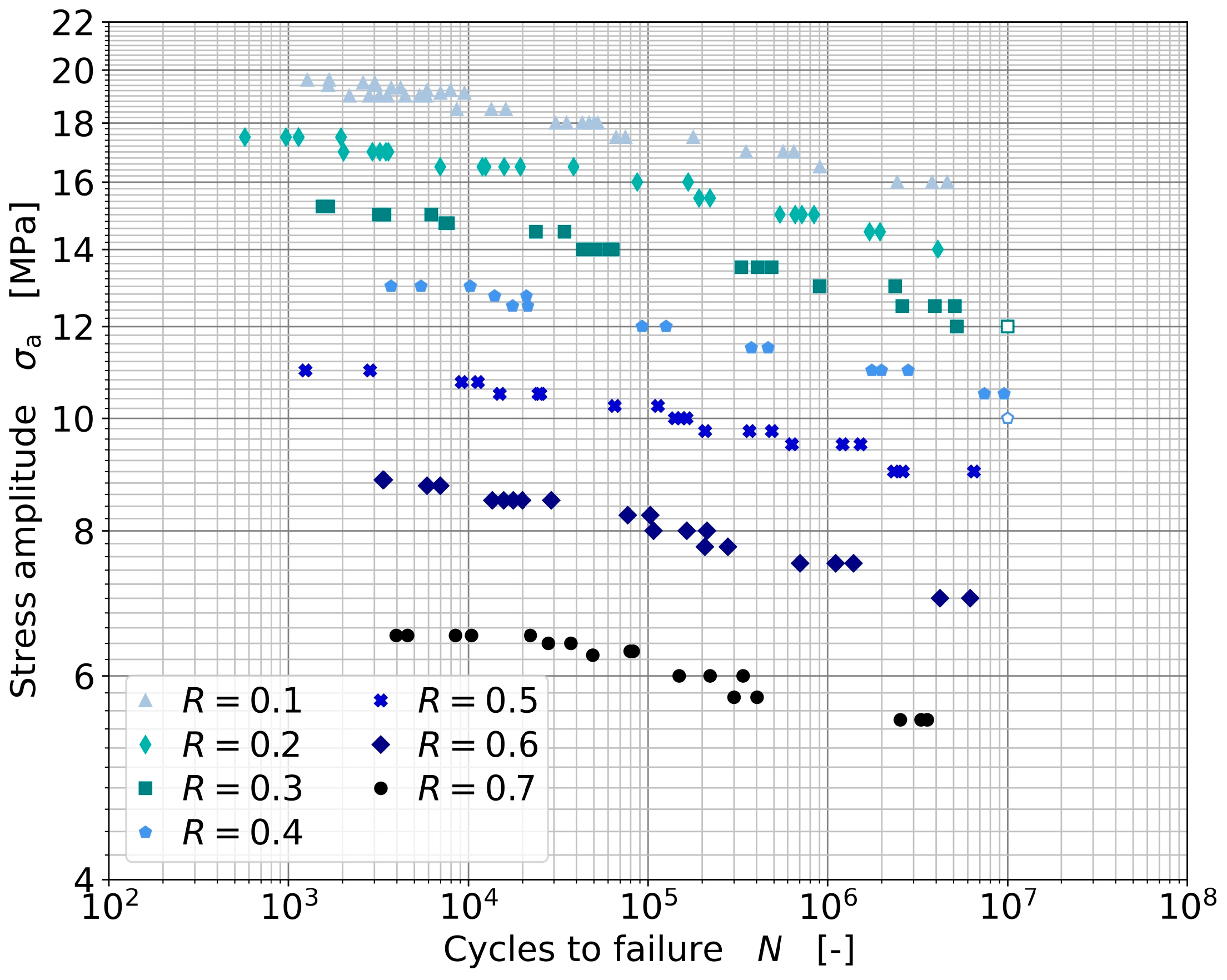
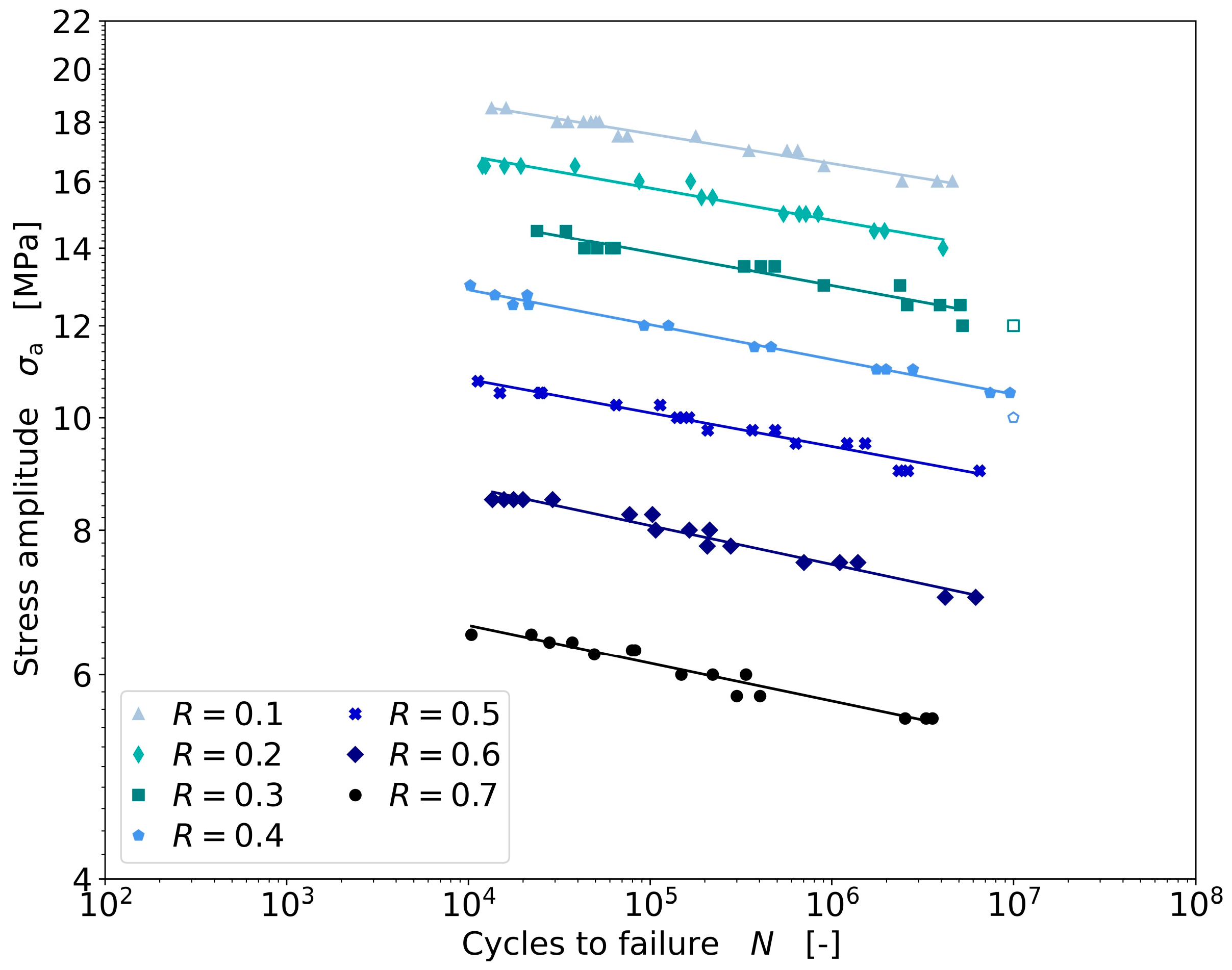
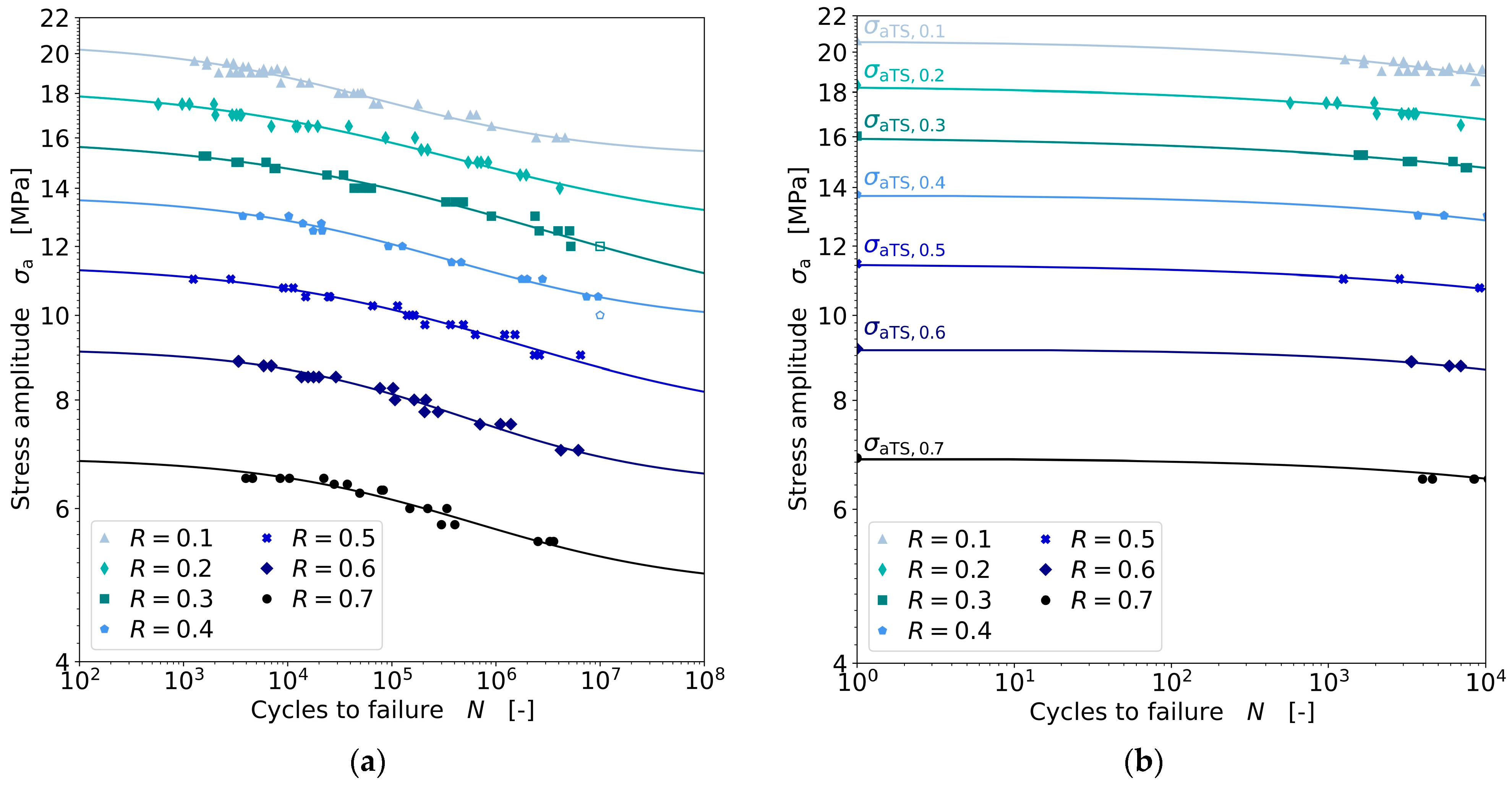
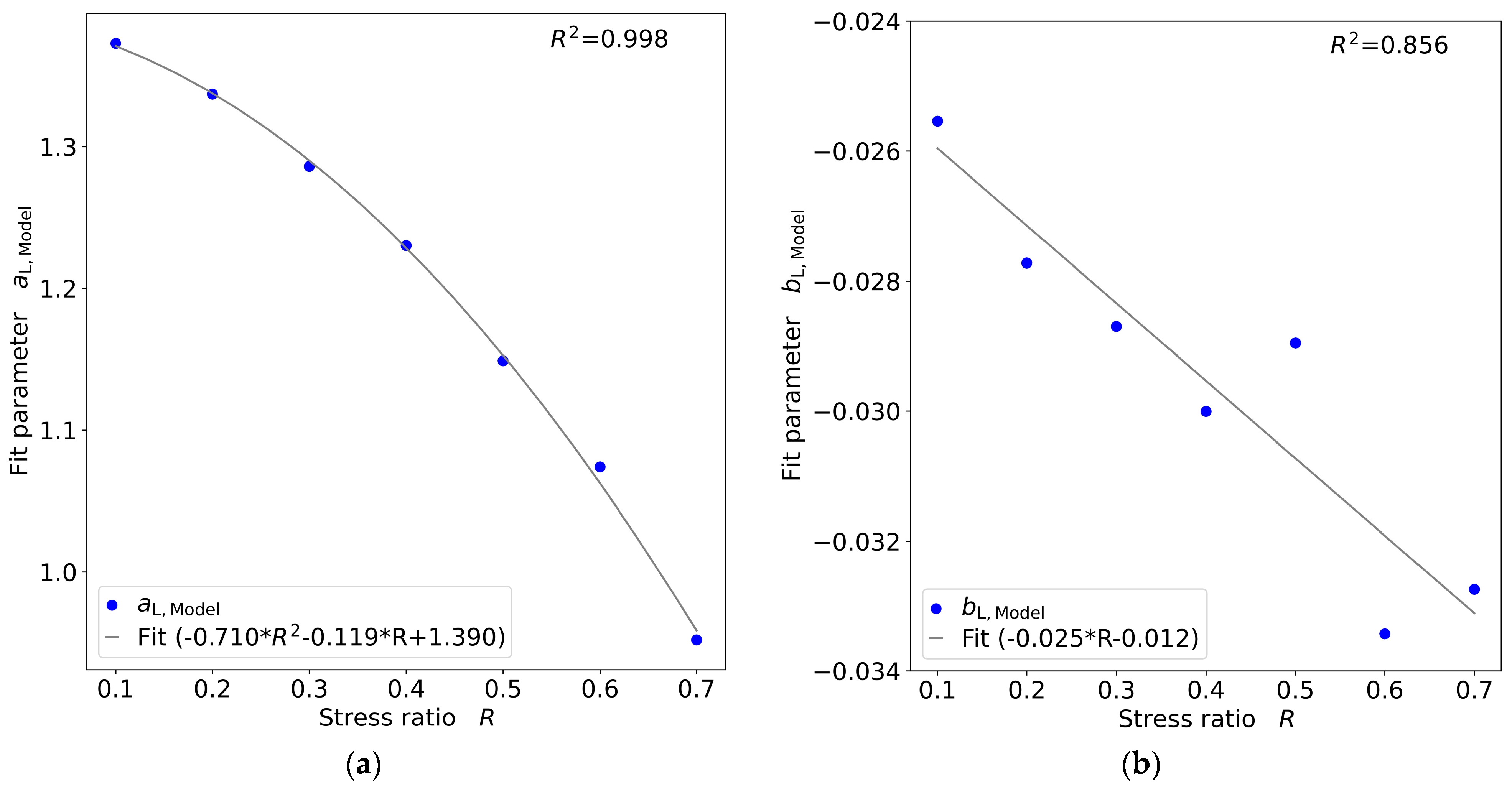

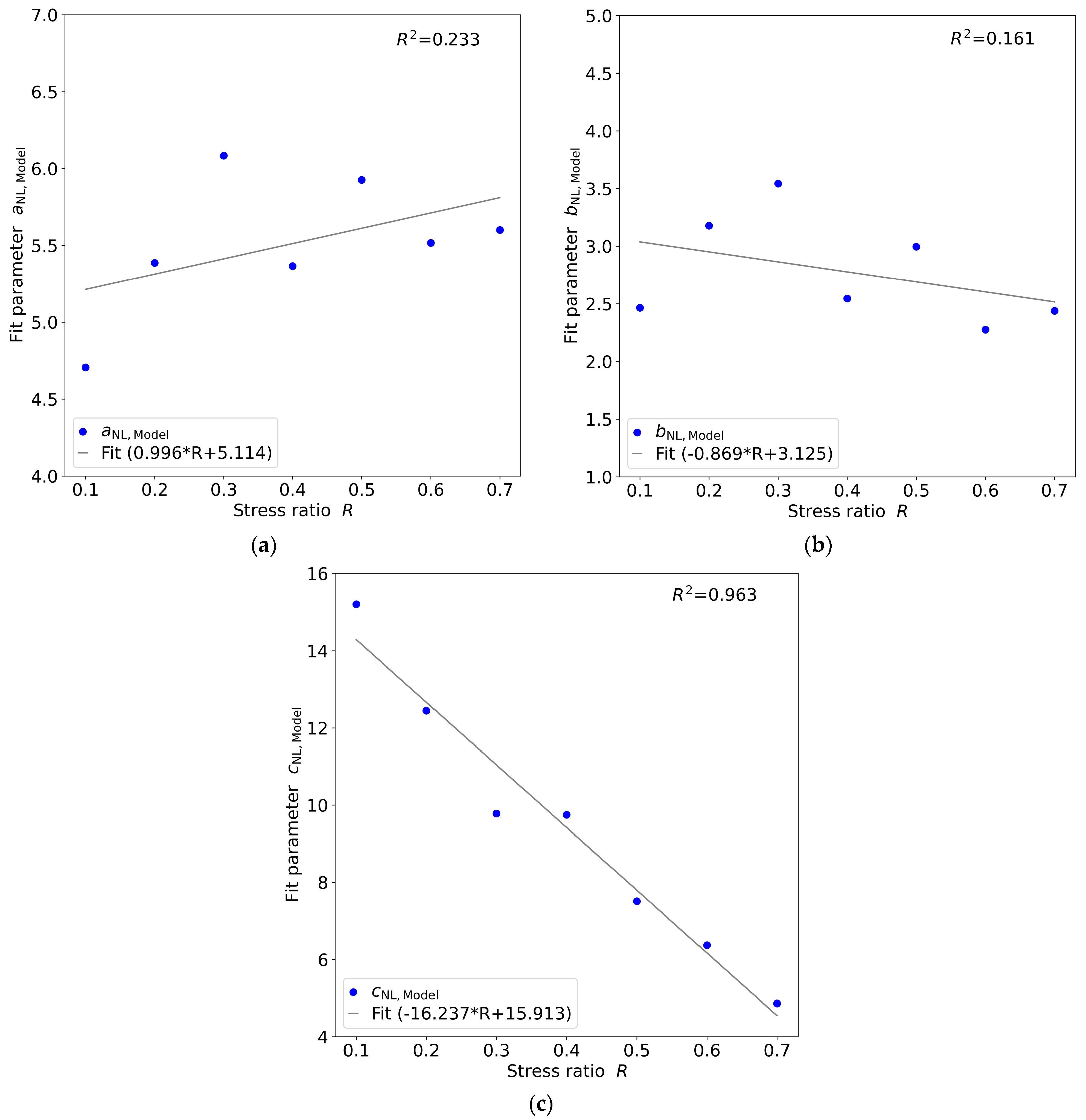

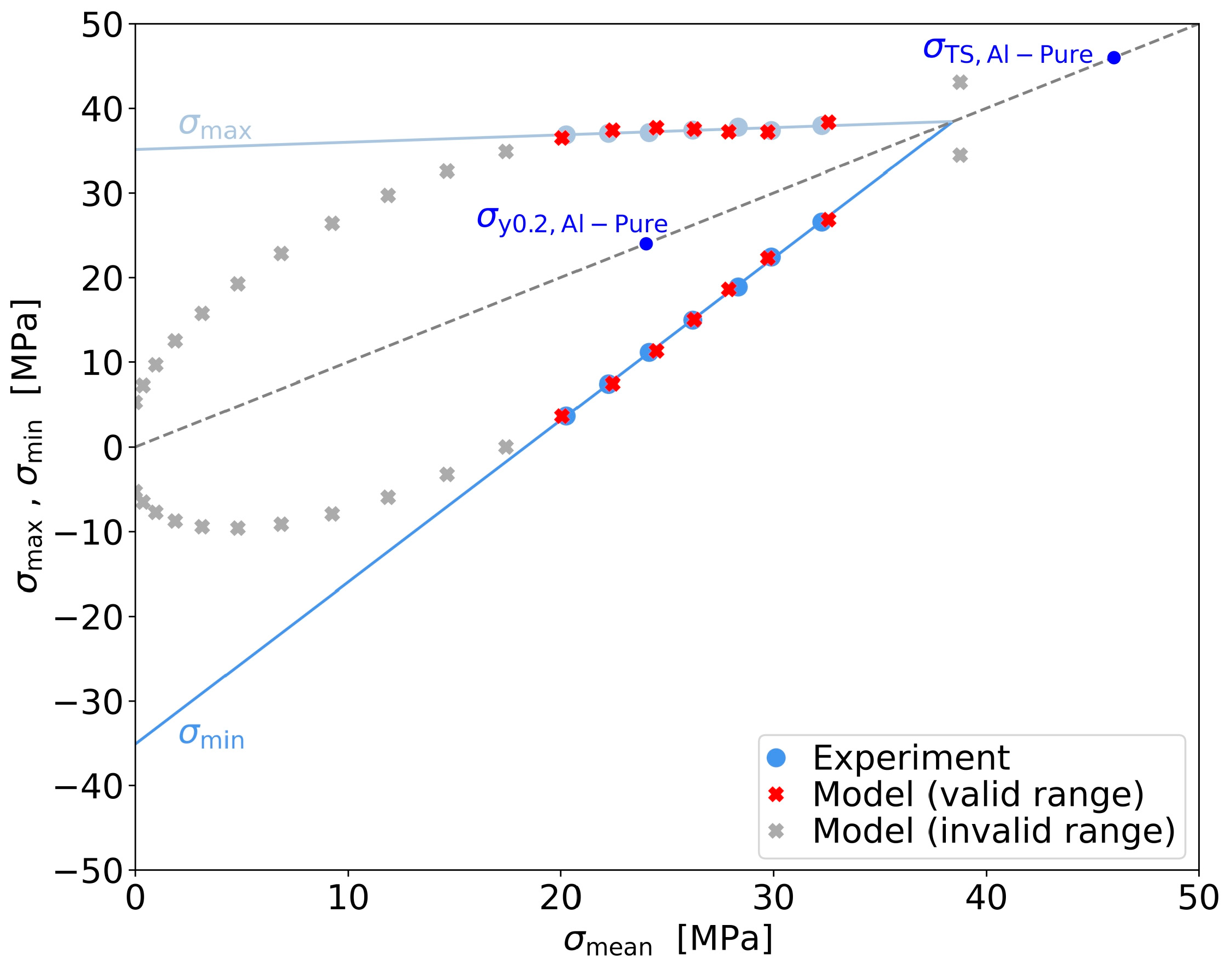
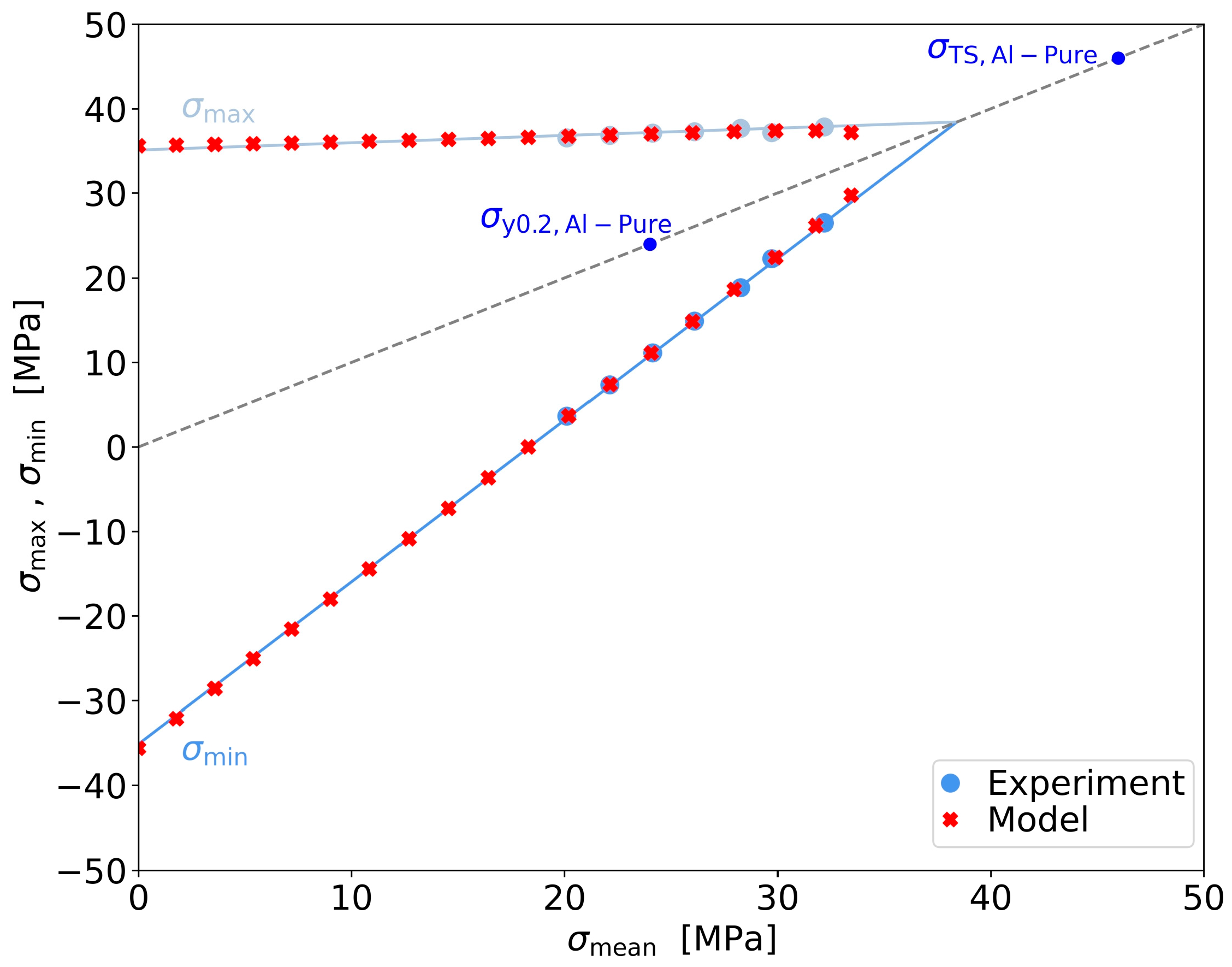
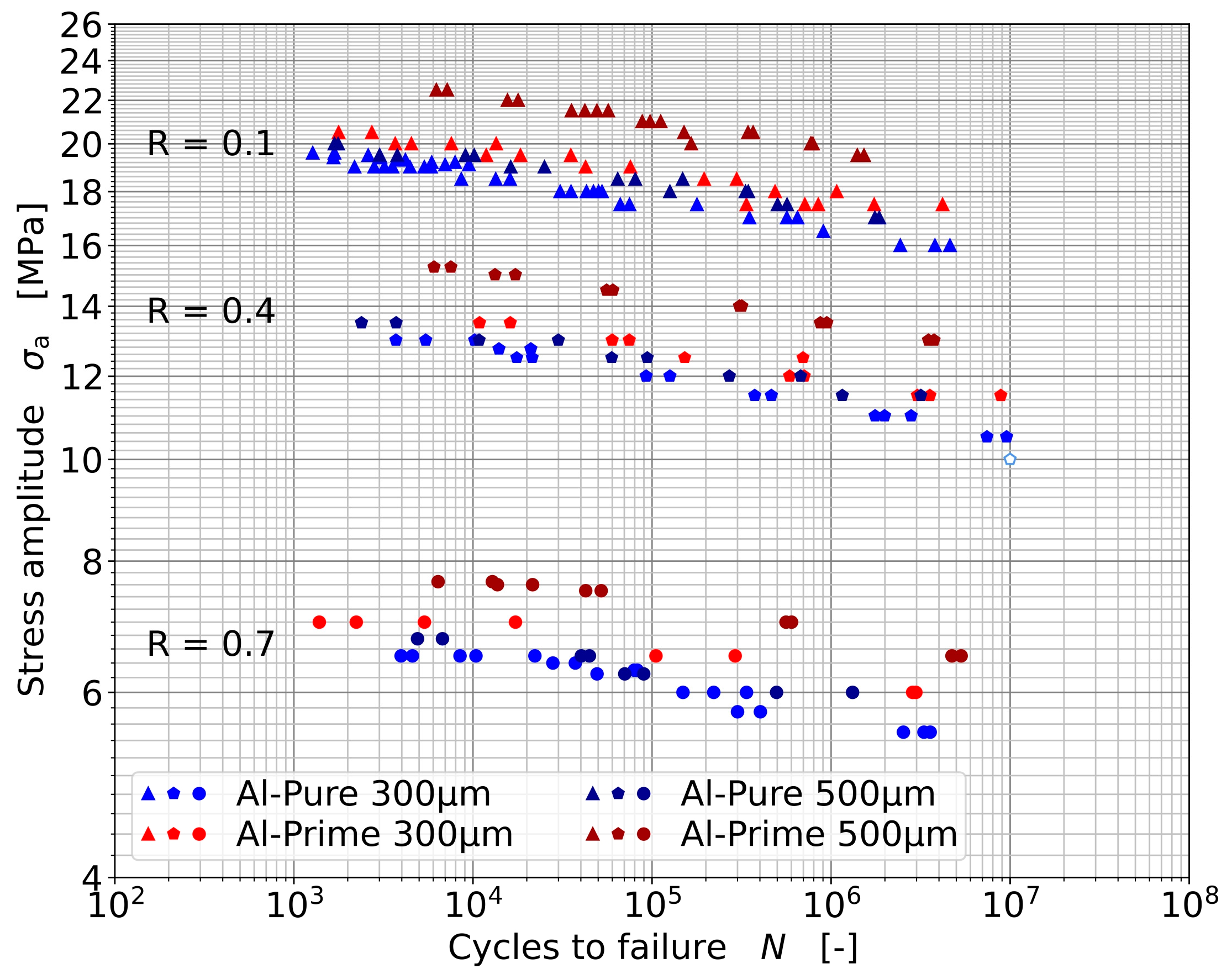

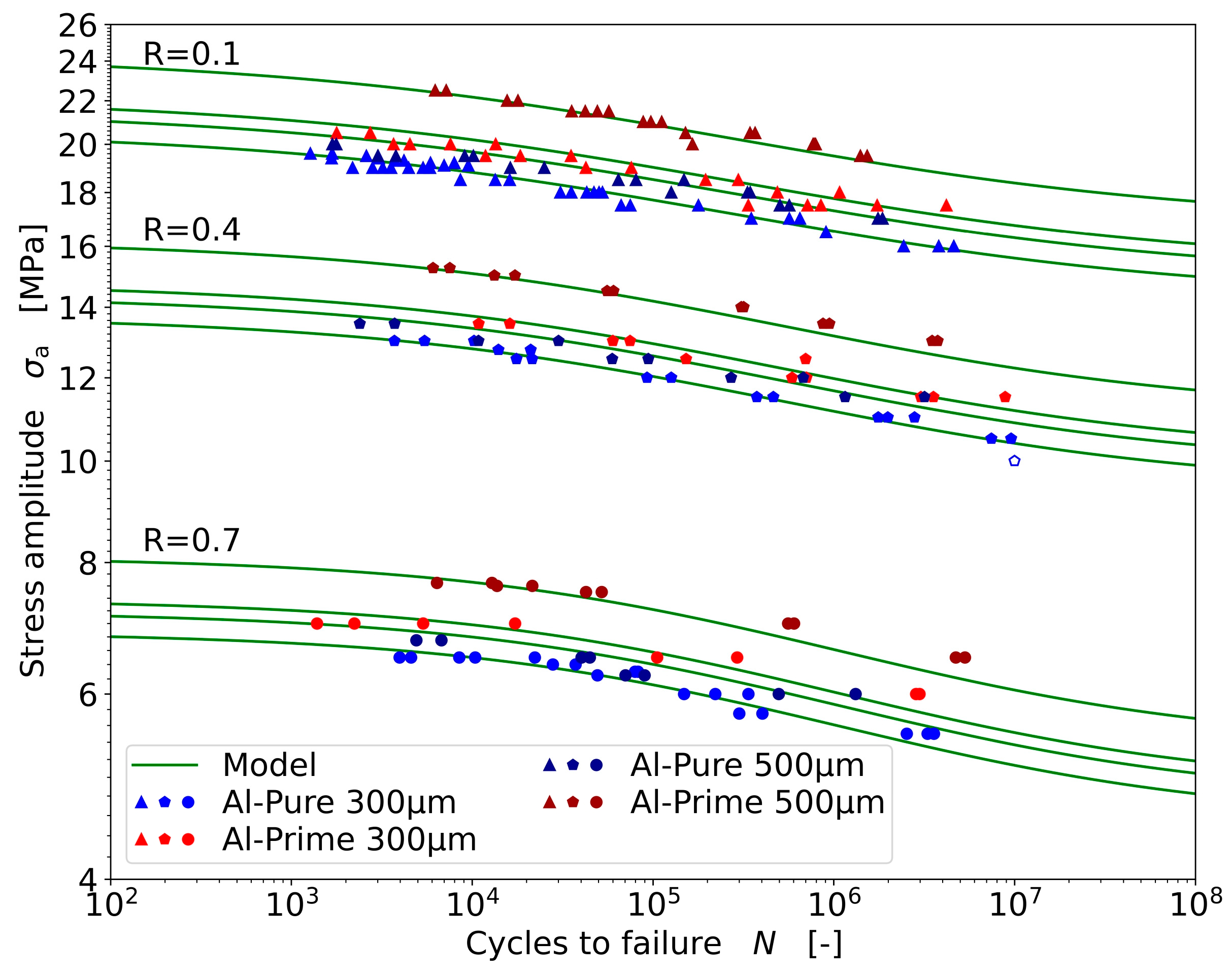
| [MPa] | [MPa] | |
|---|---|---|
| Al-Pure 300 µm | 23.9 ± 0.7 | 45.8 ± 0.2 |
| Al-Pure 500 µm | 32.1 ± 0.5 | 47.9 ± 0.5 |
| Al-Prime 300 µm | 30.8 ± 0.7 | 49.2 ± 0.5 |
| Al-Prime 500 µm | 31.3 ± 0.3 | 54.0 ± 0.1 |
Disclaimer/Publisher’s Note: The statements, opinions and data contained in all publications are solely those of the individual author(s) and contributor(s) and not of MDPI and/or the editor(s). MDPI and/or the editor(s) disclaim responsibility for any injury to people or property resulting from any ideas, methods, instructions or products referred to in the content. |
© 2023 by the authors. Licensee MDPI, Basel, Switzerland. This article is an open access article distributed under the terms and conditions of the Creative Commons Attribution (CC BY) license (https://creativecommons.org/licenses/by/4.0/).
Share and Cite
Moers, C.; Dresbach, C.; Altenbach, H. A Fatigue Lifetime Prediction Model for Aluminum Bonding Wires. Metals 2023, 13, 1781. https://doi.org/10.3390/met13101781
Moers C, Dresbach C, Altenbach H. A Fatigue Lifetime Prediction Model for Aluminum Bonding Wires. Metals. 2023; 13(10):1781. https://doi.org/10.3390/met13101781
Chicago/Turabian StyleMoers, Cassandra, Christian Dresbach, and Holm Altenbach. 2023. "A Fatigue Lifetime Prediction Model for Aluminum Bonding Wires" Metals 13, no. 10: 1781. https://doi.org/10.3390/met13101781
APA StyleMoers, C., Dresbach, C., & Altenbach, H. (2023). A Fatigue Lifetime Prediction Model for Aluminum Bonding Wires. Metals, 13(10), 1781. https://doi.org/10.3390/met13101781







